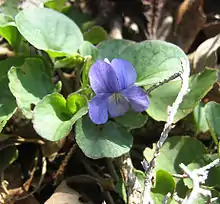| Viola walteri | |
|---|---|
 | |
| Scientific classification | |
| Kingdom: | Plantae |
| Clade: | Tracheophytes |
| Clade: | Angiosperms |
| Clade: | Eudicots |
| Clade: | Rosids |
| Order: | Malpighiales |
| Family: | Violaceae |
| Genus: | Viola |
| Species: | V. walteri |
| Binomial name | |
| Viola walteri House | |
Viola walteri, the prostrate blue violet,[1] is a perennial plant in the violet family (Violaceae). It is native to Southeastern and Appalachian North America. It is generally uncommon throughout its range, with populations becoming fragmented in the north. Viola walteri is found in rich calcareous forests and woodlands, often in dry rocky areas. It is a spring ephemeral, flowering March through May. It distinguished by its creeping, rooting stolons, which is thought to be indicative of it being transitional between the caulescent and acaulescent violets.
This species is similar to Viola appalachiensis, which was once considered a variety of Viola walteri.[2][3]
References
- ↑ USDA, NRCS (n.d.). "Viola walteri". The PLANTS Database (plants.usda.gov). Greensboro, North Carolina: National Plant Data Team. Retrieved 6 August 2015.
- ↑ Digital Atlas of Virginia Flora
- ↑ "Flora of the Southern and Mid-Atlantic States".
This article is issued from Wikipedia. The text is licensed under Creative Commons - Attribution - Sharealike. Additional terms may apply for the media files.